
Zephyrin_xirdal has a terrific cyberpunked living post on Xirdalium where he highlights the similiarities of every day building interiors with Brazil - specifically our restaurants. In Gilliam’s Brazil, ventilation pipes are the symbol for technology run rampant. There’s something disturbing about noticing how omnipresent these things are in our restaurants. So, um, next time you check out your favorite restaurant, don’t look up!!!
This post has been filed under Cyberpunked living by SFAM.
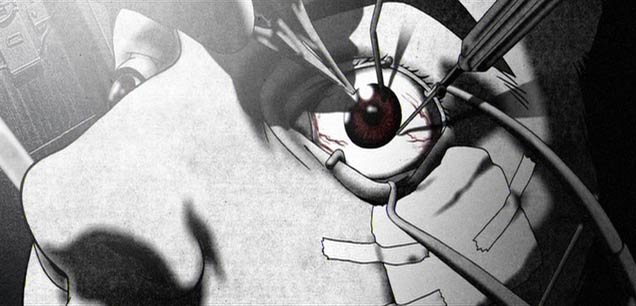
The Institute for Ethics and Emerging Technologies (IEET), recently held a conference at Stanford University Law School on Human Enhancement Technologies and Human Rights (HETHR). The description for the conference described the purpose as follows:
Defenders of enhancement argue that the use of biotechnologies is a fundamental human right, inseparable from the defense of bodily autonomy, reproductive freedom, free expression and cognitive liberty. While acknowledging real risks from genetic, prosthetic, and cognitive enhancement, defenders of enhancement believe that bans on the consensual use of new technologies would be an even greater threat to human rights.
Health care, disability and reproductive rights activists have argued that access to technology empowers full and equal participation in society. On the same grounds a generalized right to “technological empowerment” might connect defenders of enhancement technologies with disability activists, reproductive rights activists with would-be parents seeking fertility treatments, the transgendered with aesthetic body modifiers, drug policy reformers and anti-aging researchers with advocates for dignity in dying.
Yet, what, if any, limits should be considered to human enhancement? On what grounds can citizens be prevented from modifying their own genes or brains? How far should reproductive rights be extended? Might enhancement reduce the diversity of humanity in the name of optimal health? Or, conversely, might enhancements inspire such an unprecedented diversity of human beings that they strain the limits of liberal tolerance and social solidarity? Can we exercise full freedom of thought if we can’t exercise control over our own brains using safe, available technologies? Can we ensure that enhancement technologies are safe and equitably distributed? When are regulatory efforts simply covert, illiberal value judgments?
Between the ideological extremes of absolute prohibition and total laissez-faire that dominate popular discussions of human enhancement there are many competing agendas, hopes and fears. How can the language of human rights guide us in framing the critical issues? How will enhancement technologies transform the demands we make of human rights?
The IEET is associated with the World Transhumanist Association, which is headed up by Citizen Cyborg author and Cyborg Democracy Blog contributor, James Hughes.

The Reviews: George Dvorsky, a Board member of IEET had a quick post listing a number of the reviews. Depending on which review you read for the HETHR conference, you could take away that this was either one of the most enlightening debates of the decade or that was a conference filled with left-wing crackpots espousing half-baked theories one would expect after a bad LSD trip. Not surprisingly, George thought the event was a smashing success:
The central focus of the conference was to construct a case for human enhancement based upon the lofty principles of human rights, liberalism and bodily autonomy. The event was in no small way a direct challenge to the burgeoning anti-enhancement camp that has arisen in recent years to combat what is perceived to be a threat to human dignity and humanity itself. Organizers of HETHR hoped that the conference would demonstrate that a viable and compelling case could be made in favour of enhancement. Based on what I heard at the event, I would say it was mission accomplished.
Hmmm…Mission Accomplished seems to have taken on a different meaning these past few years - yet in this case, perhaps the words were well chosen. Others clearly disagree. Wesley Smith from the Weekly Standard writes:
I just got home from a transhumanism conference (”Human Enhancement Technologies and Human Rights”) being held at Stanford through tomorrow (Sunday). Among the items I learned today are: Feminist bioethics supports genetic engineering so that men can be altered to have babies and women can be freed from the tyranny of menstruation; animals should be enhanced to permit them to become equivalent to humans, including the ability to use the Internet–before, that is, all animal life is transformed into non biological states of existence, which apparently the living planet Gaia requires in order to survive; funding anti-aging research is more important than funding treatment for fighting disease in Africa; we probably should permit people who want to be amputees to achieve their desires; and, freedom requires a maximum morphological license to enhance our biological units.
If this is at all representative, I would have to agree that the animal part is especially odd. Who gives us the right to transform elephants or Dolphins, for that matter? Modifying our brains to be able to communicate with Dolphins - Cool! Modifying dolphins to communicate with us, and only then asking their permission if this was a good idea? Not cool. Then again, I’m guessing this is a slightly biased assessment. William Saletan from Slate.com submitted a slightly kinder assessment, although not by much:
Remember those kids who played Dungeons & Dragons and ran the science-fiction club in your high school? They’ve become transhumanists….De Grey, the guy with the beard, called for higher taxes and research funding to “end the slaughter” of human aging. He argued, incoherently, that our failure to do everything possible to stop aging this instant was tantamount to mass murder. He also floated the creepy idea that overpopulation might not become a problem because once we’re immortal, we might realize children are no fun. Even so, he asked the kind of penetrating question only a big-thinking oddball would come up with. Are we stuck in a “trance” of fatalism about aging? If we realize it can be slowed or stopped, “will aging become repugnant,” like any other disease?
My favorite panel began with the president of the Toronto Transhumanist Association. He runs a Web site called betterhumans. He and I share a moral objection to killing animals. But letting animals live isn’t enough for him. Inspired by an experiment in which chimpanzees were given a kitchen and flush toilets, he wants to use cyber- and biotechnology to elevate all animals to human status. “Anything less than human-level capacity would be unacceptable,” he declared—including the ability to operate tools remotely through the Internet.
He was followed by a transsexual transbemanist. Transhumanism, apparently, is too parochial. It’s too focused on humans, too narrow for the “mindfiles,” “mindware,” and “virtuality” into which we’re going to upload ourselves. According to the speaker—picture Willie Nelson with a shave—our identities can be broken down into units called bemes, in the same way that culture can be broken down into memes. These, in turn, can be “bemed up” and preserved in media outside our bodies. As examples, she suggested your smile, how lasagna tastes to you, and your memory of your first bike ride. The idea of extracting such plainly body-dependent things is ridiculous. But her basic point is right: Bemes, not genes, are what capture and preserve our essence.
Considering I used to play D&D non-stop (I was too busy with D&D to help organize the SF&F club at school), I felt sort of an affinity here. Again though, I got the feeling from reading the reviews that perhaps the most extreme aspects of the conference were being relayed. Dale Carrico from IEET responded to this already, so I won’t too much more into it.
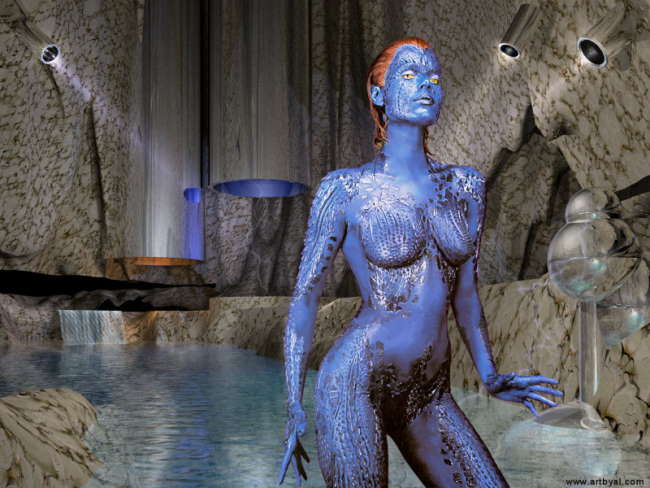
Brian Alexander of MSNBC linked transhumanism with the new X-Men movie - I guess this means the Transhumanism movement will suffer many key deaths along the way, but will ultimately be responsible for a problematic narrative with lots of explosions (hmmm…maybe this is accurate!). Actually, Brian’s article seemed a bit more balanced:
Transhumanism is being taken seriously by an increasing number of scholars. The fact that Stanford’s respected legal bioethics program hosted the 150 or so attendees from Europe, Asia, New Zealand and North America to discuss issues raised by human enhancement is testimony to how far transhumanism has come in from the fringe…
Still, the idea of modifying people does have a great many ethical implications, as keynote speaker Walter Truett Anderson pointed out. Anderson, president of the World Academy of Art and Science, a consultant, and an author of books about the human future, asked his audience to consider the health of the planet when they thought about what rights people should have to change our biology. There is more at stake, he said, than just ourselves. We are part of something bigger.
“We will have to think about it in a global context,” he told me. “A new population problem looms, which has to do, not with birth rates, but death rates and the question of whether we can begin to increase life spans for large numbers of people,” a prospect that could tax global resources.
The best account of the conference for those like myself who did not attend comes from Nydra’s Existence is Wonderful blog. Nydra’s Introduction and 5 Part Series goes in-depth at a number of sessions, and gives the perspective that perhaps some in-depth thought actually took place there. She does a terrific job at laying out the POV of the speakers, and then gives her thoughts on it. While I may not agree with her on everything, I certainly very much appreciate the detailed effort she put into this, and will probably spend lots more time perusing them.

Left Wing Loonies or Something More? The Slate review above briefly mentions a struggle for the heart and soul of the Transhumanist movement in saying, “A while back, I’m told, there was a left-right battle for the soul of transhumanism, and the left won..” It appears that one casualty of this struggle is Simon Young. He has the belief that the World Transhumanist Association and its leader, James Hughes, are members of the “Loony Left,” who have essentially gone off the deep end of transhumanist thought. He details his thoughts in Wesley Smith’s review above. His biography states the following:
“Son of the pioneering English cybernetician and author, J. F. Young ( 1929-94), whose seminal books included Cybernetics (1969), Robotics (1973), and Cybernetic Engineering (1973) , Simon Young is an accomplished pianist and composer who has performed across Europe . This unusual combination of influences, musical romanticism and scientific rationality, informs his Transhumanist philosophy – the passionate belief in striving to transcend human limitations through reason, science and technology.”
I have a masters in Cybernetics and General Systems Theory, but I must confess that I’ve never heard of his father’s books (more to add to the stack I suppose). In any event, Simon has created a competing organization called the World Transhumanist Society. On the whole, I sort of like his evolution over revolution approach, but the WTS at this point seems like nothing more than a web page. Has anyone joined this, or is Simon a lost voice in the wilderness?

So What Do I Think of All This? As for my own thoughts, I must admit, I’m still thinking about this whole movement, so if my thoughts seem ill-formed, please feel free to set me straight. The part that really bothers me about this whole debate deals with the seemingly single-minded pursuit of transhumanism without regard to the massive potential for unintended consequences. Our cyberpunked future may indeed be wonderful, but it has just as much potential to turn into a modern-day dystopia, not unlike many of the movies we see here. If my schooling in anthropology and cybernetics has taught me anything, it’s that most people think in terms of cause and effect changes, while actual change is very counter-intuitive and interlinked - making explicit wholesale changes to society really should involve an understanding of the complexities involved. Societies are held together by stable patterns of interaction and some semblance of a shared way of life. Simply because we develop the power to change every aspect of ourselves or our society doesn’t necessarily imply that doing so will result in the betterment of mankind. By no means am I advocating we should rise up in anger at the transhumanism movement, but we should demand enlightened thought, and a comprehensive societal risk assessment for innovations that could lead to massive societal change.
In terms of priorities, it seems rather clear that the HIGH priority for posthuman research (after the development of high quality vampire teeth, of course) should be in helping those with disabilities and lost body parts. If there is anything good about the Iraq conflict, its the massive dollars going into research in prosthetics.
Thoughts?
This post has been filed under Cyberpunked living, News as Cyberpunk by SFAM.

Quinn Norton from Wired has a pretty intriguing article on using magnets as body implants in order to begin to develop awareness of electromagnetic fields. He actually went ahead and got a magnetic implant in his finger.
I took a trip to Phoenix to have Haworth implant a magnet in me last September. Because body-mod artists are not medical practitioners, ice was the only anesthetic available. My finger was soaked in ice water until it began to hurt. After that, Haworth acted quickly to get as much of the implant done as possible while my hand was still numb from the cold.
The initial cut did hurt, but not unbearably. He sliced open my finger with a standard scalpel, inserted a tool to make a gap for the magnet, and tried to insert the magnet in one nonstop motion. The insertion didn’t work, and he widened the cut and tried again. This time it worked, and he closed the cut with a single suture. The suture was the most painful step — an indicator that the cold “anesthetic” had worn off. The process took less than 10 minutes. My finger was slightly swollen and sported a blue, knotted plastic thread.
When we were done we sat in Haworth’s living room. He brought out a magnet and handed it to me. I brought it near my finger and felt the magnet move for the first time up against the raw inside of my finger. I startled visibly, and Haworth grinned. “Welcome to your new sense,” he said…
…The magnets are small, and once encased in skin, all they do is react next to nerves, conveying the presence of sufficiently strong electromagnetic fields. “The magnetic implant is not the most sophisticated or rich sensation, it was just the easiest to implement with our available technology,” says Huffman.

Damn! Soaking your finger in ice and then slicing?? That’s true hardcore!! Unfortunately, things don’t always go as expected. Often, the silicon coating breaks down, rendering your finger prone to infection. Bezine has an article that graphically shows the removal procedure when things go wrong.
Several months after having the procedure, some people begin to have problems. Some magnets begin to turn dark under the skin, suggesting the bio-neutral silicone sheath is failing. Exposure to the body starts breaking down the magnets.
Two months after my own magnet was inserted, and long after the cut itself had healed, I experienced one of these problems firsthand. My shielding breached and the implant area became infected. The infection resolved, but the region turned black and my sixth sense evaporated.
My family doctor tried to remove the magnet and failed. Instead, the implant shattered into pieces, and I could no longer pick up other magnets with my finger. After months of ESP, all I had left was a sore digit with a dark spot.
I figured that was the end, but it wasn’t. Four months after I lost all effect, the spot darkened and the magnetism returned. The magnet — being a magnet — had reassembled itself in my finger. While it’s nowhere near as sensitive as it once was, I can once again pick up other magnets.
The interesting thing this shows is that decent percentage of the population are really interested in expanding human capabilities through technology enabled solutions. True cyborgs aren’t going to remain solely in the realm of science fiction for long. But um, hopefully they get better anesthetics than ice for this type of operation in the future.
This post has been filed under Cyberpunked living by SFAM.
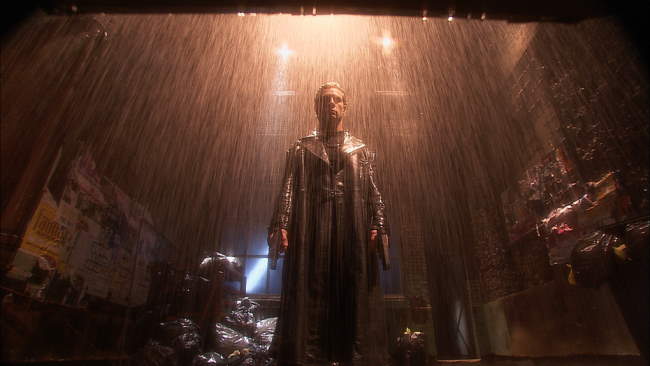
Case passed along this interesting little tidbit from Twitch (which is quickly becoming one of my favorite sites) about a Matrix inspired nine minute Film Short from France. The synopsis is briefly given as follows:
Ram and Greg are two survivors living in a post apocalyptic world ruled by the Machines. Greg has successfully created a virus program named “Resistant” that can exterminate the Matrix Agents.

WE Productions, the French group producing this new short, also produced a counter-strike short a while back has a flash-enabled website for this new short which includes a trailer, screencaps and a forum (click the flag for English). The trailer looks like it has decent production values and seems to mimic the Matrix universe pretty well, but the trailer doesn’t give us enough to indicate whether the plot of short itself will be interesting (the trailer for Cost of Living effectively did this I thought).
No word yet on when this will be released, and unfortunately the forum appears to be in French only. Perhaps one of my non-linguistically challenged European visitors can post a message there and ask when this will be released.
This post has been filed under Upcoming Movies by SFAM.

Cyberpunk Guru Mac Tonnies over at Posthuman Blues found a poston Better Humans that discusses the potential for developing a singularity by 2014. An AI development company named Novamente is looking for funds to make a massive investment in AI to hasten the development of a singularity:
According to Novamente’s project plan, with proper funding they will have human-level AI in six years. Their goal is to create a learning system that can ultimately be self-improving. By this year or next, they aim to have an autonomous intelligent infant interacting in a simulated world. By 2009 at the latest, they’re aiming for the equivalent of a young child. By 2014, at the far end of the spectrum, they aim to have an AI that can reason abstractly and communicate in complex English. As early as 2010, they may have a “strongly self-modifying AI.” And that, as most readers will know, could kickstart a rush into the Singularity.
While this is pretty cool, one wonders if the bar for a signularlity is being scaled back. If you ask 5 people for a definition of a singularity, rarely will you find any concurrence among the definitions. While I truly wish Novamente all the success possible, I almost wonder whether we would agree with them if they actually declared success.
This post has been filed under News as Cyberpunk by SFAM.
Movie Review By: SFAM
Year: 2005
Directed by: Michael Bay
Written by: Caspian Tredwell-Owen, Alex Kurtzman & Roberto Orci
IMDB Reference
Degree of Cyberpunk Visuals: High
Correlation to Cyberpunk Themes: Medium
Key Cast Members:
Lincoln Six Echo/Tom Lincoln: Ewan McGregor
Jordan Two Delta/Sarah Jordan: Scarlett Johansson
Merrick: Sean Bean
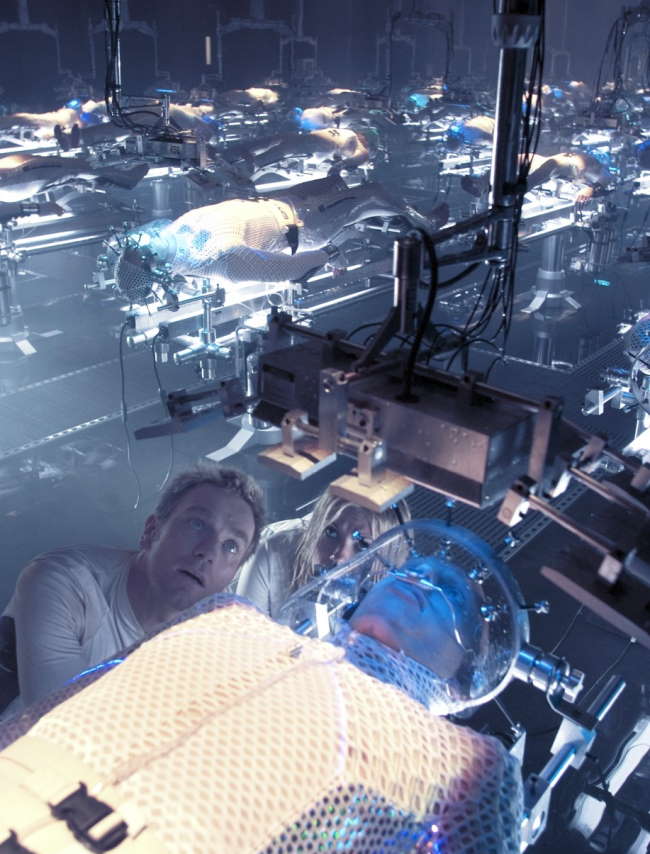
Overview: The Island is straight Hollywood fare from the get go. In this summer bubble gum scifi-action romp, you’ll find few original ideas here, or even a coherent plot, but you will find loads of awesome visuals and even more action scenes and explosions. Vast amounts of money went into creating some rather incredible action sequences. Unfortunately, with all the thought devoted to creating those sequences, there apparently was little left for the story itself. Still, Scarlett Johansson looks absolutely gorgeous in The Island, and Ewan McGregor works as a leading man.

The Story: In the future, the desire among the rich and famous to live for ever dominates their existence. Along comes Dr. Merrick (Sean Bean) who founds the Merrick Corporation to meet this market need. The Merrick Corporation has (supposedly) found a method to take a person’s DNA and clone all of their organs within a gelatinous blob that maintains a persistent vegetative state. Unfortunately, they were never able to make this work, so instead, the Merrick Corporation broke all the laws and went with straight cloning of their human sponsors. For a cool 5 million bucks, sponsors can buy an insurance policy to ensure they always have a perfect set of organs that can be harvested to save them from whatever malady arises.
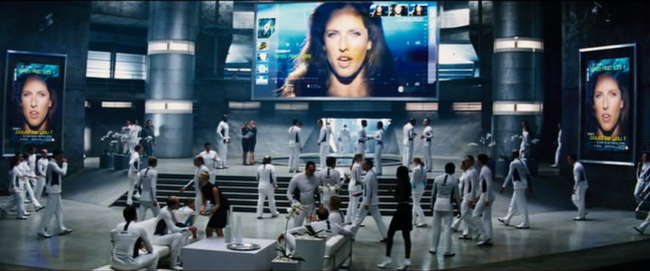
To keep the clones under control, Dr. Merrick constructs an alternate reality where a contaminated world has killed everyone except for a few fortunate souls who were rescued and placed into a special set of buildings. They have also saved an Island, which is now the only place on earth where people can live without dying. Now all the clones await their turn in the lottery, which, if won, supposedly means they will be able to go to the Island. In reality, the clones are “selected” when their sponsor has need for one of their body parts. From their diet to their associations with others to their urine output, every aspect of a clone’s life is monitored. THX-1138’s surveillance society, right down to the oppressive white, is omnipresent in The Island.
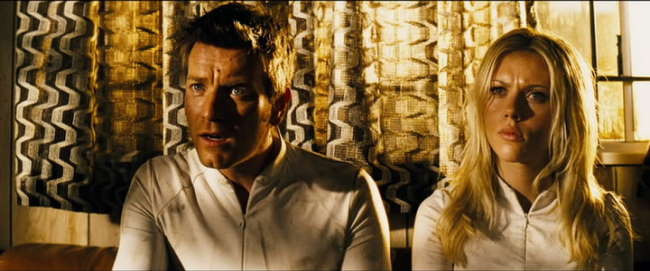
Lincoln Six-Echo, played by Ewan McGregor, is a clone who starts questioning his surroundings. He eventually gets out (through a completely idiotic plot point) and realizes that that those who leave to go to the Island are in fact being murdered. He quickly goes back to get his close friend, Jordan Two-Delta (Scarlett Johansson) who just yesterday was selected to go to the Island (her sponsor is dying from wounds suffered in a car crash). Together, they make a break for it, but are pursued by (we are told) a crack-group of ex-special forces agents led by Djimon Hounsou. With the help of a low-level employee (Steve Buscemi) that Lincoln Six-Echo befriended, Lincoln and Jordan make for Los Angeles in an attempt to find Lincoln’s sponsor to discover the truth. From there, The Island turns into a high-tech, futuristic chase movie, with continually larger explosions and action sequences dominating screen. I won’t spoil the ending for you, but suffice to say this movie is as predictable as they come.

Michael Bay’s Approach to Story Telling: It’s pretty clear that director Michael Bay doesn’t plan movies like most directors. He seems to pay FAR more attention to the visual progression than he does the actual dialogue. The narrative in Island, like most of his movies, simply doesn’t hold together. To buy it, you have to accept all sorts of inane action on the part of the characters. Michael Bay seems to construct his movies via storyboards alone – for instance, he knows that in the end, the hero and the bad guy need to fight on a high-tech, scary looking bridge with explosions going on in the background – he is far less concerned about the rationale that brings them together. In watching it, the Island is one of those rare movies that is actually more coherent if you turn off the sound. The story you make up to go with the visuals will almost certainly make more sense then some of the plot points Bay provides.

I don’t even mind that we have to accept that two clones, three and four years old, are able to outwit an entire platoon of ex-special forces personnel, or that they “magically” assume all of their cloned person’s skills (like riding flying motorcycles). I can even accept that a supervisor on a regular basis, gives a clone a key that gets him to the outside world to save the supervisor from running errands, or that the the police regularly park their squad cars in the middle of an intersection and then don’t look for broadsides, but some of the basic plot stuff really does bother me. In the Island, the cloning is a HUGE secret that implicates the entire corporation into illegal action, but none of the investors, including the Defense Department which as spent 120 Billion on this “technology,” ask any questions. Even more incredible, none of the hundreds, if not thousands of low-level employees have ever consider spilling the beans. Instead, they are so closed-mouthed, they don’t even tell their family members. Killing is cool for them, as long as they get to keep their meager paychecks. This is just one example – far worse are the ending plotlines, which have our heroes assuming that top-notch special forces personnel wouldn’t search them for weapons even after they’ve shot people (lucky for them, the special forces personnel complied), that hired thugs would hang out and watch their boss go mono-a-mono with the hero vice wasting our hero, and that the boss himself, up in the comfort of his office, would be able to make it to the hero far quicker than any of his hundred thugs who’s job it is to enforce the peace.

Product Placement Gone Wild: It’s kind of refreshing to know that in the future, all dehumanized clones have to wear Puma shoes and clothing, drink Aquafina, serve Ben & Jerry’s Ice cream to kids, model for Calvin Kline on billboards, play Xbox, seek out MSN Search as a phone book, conduct their slave work on Apple computers, steal American Express credit cards, snag rides on Mac Trucks, wear Monza watches, and look longingly at Michelob Light beers. And of course, EVERYONE will be driving either Cadillacs or Dodge Magnums in the future. The Bond movies, where you expect significant product placement, don’t hold a candle to the monstrosity that is The Island. Not only do we get an obscene number of product placements, the on-camera product “lingering” that Mr. Bay engages in is almost criminal. I felt like I should have gotten a discounted ticket due to the myriad of embedded commercials. It’s rather amazing if you think of it – that almost 70 years into the future, all these companies will still be using the same logos they use today. I must say though the product placements are very memorable – they make be both remember the product and more importantly, they instill in me the STRONG desire to never buy these products again, as I now associate these brands as contributors to fucking up my movie watching experience.

The Visuals: While I’ve bashed the Island’s plot, Michael Bay certainly deserves a lot of credit for delivering some pretty cool cyberpunk visuals. The clone development labs look pretty darn cool. Additionally, Michael Bay continually composes shots displaying wonderful color panoramas. We get gorgeous yellows and blues in a variety of textures and settings. In scene after scene, it becomes clear that while Bay isn’t too concerned about the dialogue or narrative sequences, he’s intimately involved in the look. In some cases though, the visuals, while impressive, make absolutely no sense – the worst example being the weird eye-nanobots that are needed to take pictures of the brain activity. That its necessary to have metal insects entering the eye in order to take a brainscan 70 years into the future strains credibility far past the point of reason – even worse, the brainscan cannot be processed until 48 hours!

The Action Sequences: Michael Bay is known primarily for his outrageous and visually impressive action sequences. He does not disappoint in the Island as the action is consistently top notch. We get awesome explosions, incredible chase scenes and lots of gun fire and fight sequences, all with wonderful camera angles and high quality positional surround sound. If there’s one reason to definitely not miss the Island, it’s the action sequences. Michael Bay may not be a great film maker, but he and his crew are genius at constructing creative, eye-poppingly tense action.

The Bottom Line: If there was one change I would make to the story, I would have suggested they had done away with the illegal nature of cloning (the second change would be to eliminate the magical memory transferral that happens between clones and sponsors). The Island would have worked far better if it portrayed a world were society as a whole had decided that cloned people were property. Instead, the Island practically ignores this question. But while I have a hard time suspending disbelief for the plot the Island provides us, I probably would have given it six stars, similar to a number of other Hollywood movies high quality visuals and significant plot issues. Unfortunately, the obscenely over-the-top product placement deserves at least the loss of one star. Not only are there over a dozen companies, the “linger” factor makes it clear that you’ve just paid to watch a commercial. In the end, this is simply asinine and reflects poorly on the studio (Dreamworks), the film maker (Michael Bay), and the products themselves (too numerous to mention). I would conservatively guess that the product placement easily cost the Island many tens of millions in lost revenue. The Island cost 126 million to make but only brought in 35 million, large part because virtually all reviews discussed the overbearing product placements. Word of mouth from viewers merely confirmed that if you pay to watch this in the theatre, you will be paying for commercials.
~See movies similar to this one~
Movie Review By: sfam
Year: 2005
Directed by: Jonathan Joffe
Written by: Jonathan Joffe
Length: 11 Minutes
Degree of Cyberpunk Visuals: Low
Correlation to Cyberpunk Themes: High
Key Cast Members:
Dying Man: William B. Davis
Sales Associate: Andrew Kirvanek
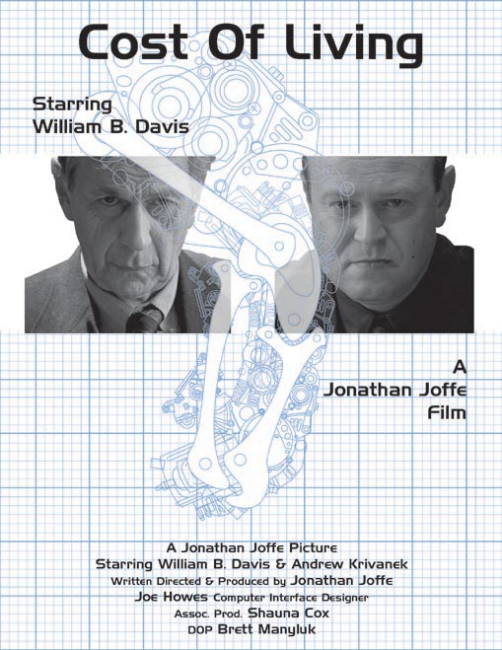
Overview: While at Balticon last weekend, I saw this wonderful cyberpunk short at the Balticon Film Festival. I still don’t know if it won or not, but Cost of Living was my second favorite (and only cyberpunk film) of the 12 mostly terrific short films shown (my favorite was a very emotional deep space scifi short film called Microgravity). Cost of Living has great production values, and goes with a light-gray/white dominating color scheme. Often, we find white in cyberpunk movies representing high-tech methods of dehumanization - Cost of Living definitely adheres to that convention.

The Story: Cost of Living takes place in a near-future time where body replacement has become all the rage. Brains are removed from their human hosts and placed into a cyborg body. Cyborg body part companies now compete on features and price, and have a range of models available, not unlike a car dealership might. A dying man, played wonderfully by the X-Files smoking man, William Davis, comes into the showroom floor of the lowest priced cyborg dealer. After going through the models, he quickly lets the salesman (Andrew Kirvanek) know that price is his driving factor. After settling the low-priced base model (the Marathon Series), they discuss financing. In the end, the dying man doesn’t have enough money. The salesman then poses him the option of, in effect, working off the cost of the new body. In essence, the deal is he would become a slave of the corporation for the next 100 years, working 14 hours a day for 6 days a week. In the end, the choice becomes 100 years of slavery or death. The set-up is very well done, and Davis especially really sells the dilemma. What would you choose?
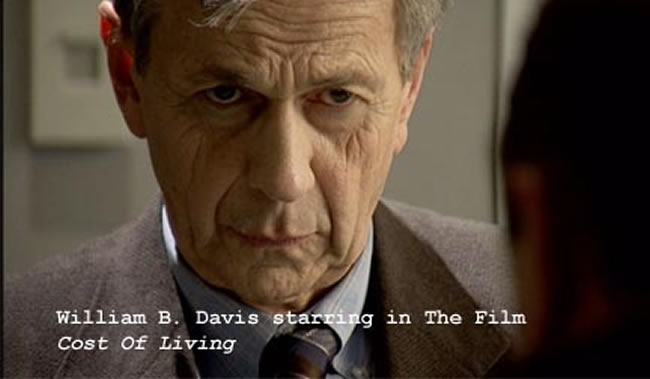
The Bottom Line: The film maker, Jonathan Joffe, taglines this film short with the question, “How much would you pay to live forever?” In essence, this actually becomes an optimistic view of the future Joffe poses. Considering the cyborg body the dying man will be receiving is bottom of the line, one is left with the question, “Will the low-end body last more than 100 years, or does it magically expire at that time, forcing the dying man to get yet another 100 year term?” This short film really does capture the essence of cyberpunk in showing unchecked corporations holding sway over humanity itself. An inside joke, having the X-files’ William Davis - the Smoking Man - dying of cancer is just a terrific little bonus!
While somewhat predictable, Cost of Living is wonderfully executed and well worth a watch. I don’t know where to point you to in order to see this short film - it doesn’t even have an IMDB film reference. I’m emailing Mr. Joffe about this - hopefully we’ll see him respond here (EDIT - Mr. Joffe responded - see the trailer in the comments).
~See movies similar to this one~
This post has been filed under Short Film by SFAM.
WordPress database error: [You have an error in your SQL syntax; check the manual that corresponds to your MySQL server version for the right syntax to use near '' at line 1]
SELECT COUNT(ID) FROM
|




























